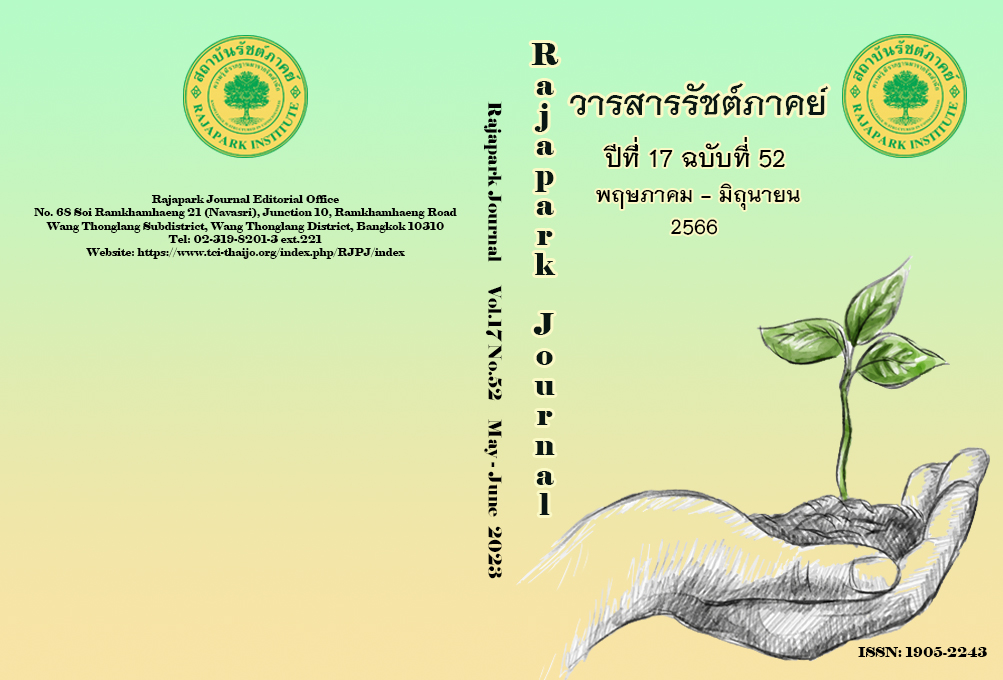The Development of Multimedia Learning Program by Using Sound Waves Images to Practice English Pronunciation of Grade 4 Students
Main Article Content
Abstract
This study aimed to (1) develop multimedia lessons by using sound waves to practice English pronunciation skills of fourth-grade students (Prathom Suksa 4) of a Thai school to be effective according to the 80/80 criterion, (2) compare the learning achievements before and after learning with multimedia lessons using sound wave images to practice English word pronunciation skills. of the students, and (3) investigate the relationship between the English vocabulary pronunciation skills and the accented dialects of students in 4 regions. The data for this study were purposively drawn from 120 fourth-grade students. The research instruments were: (1) rating–scale questionnaires; and (2) a multimedia learning program using sound waves images to practice English vocabulary pronunciation skills. The findings revealed that the multimedia learning program had shown its efficiency of 80.00/79.71. The students’ learning achievement was significantly higher, at .05 levels. The relationships between the English vocabulary pronunciation skills and the accented dialects in the Southern and Central regions were statistically significant at 0.01 level (South r=0.704; p<.01 Central r=0.675; p<.01); the Northeastern and Northern regions were not statistically significant.
Article Details

This work is licensed under a Creative Commons Attribution-NonCommercial-NoDerivatives 4.0 International License.
Views and opinions appearing in the Journal it is the responsibility of the author of the article, and does not constitute the view and responsibility of the editorial team.
References
Boonwong, A., Nuchmee, K.J. & Tamapiban, W. (2014). The Development of Multimedia Computer Instruction in English Listening - Speaking 2 Course Mattayomsuksa 4 Students. Parichart Journal, Thaksin University, 27(2), 49-63. https://so05.tci-thaijo.org/index.php/
parichartjournal/article/view/43050
Burusphat, S. (2000). Geography of dialects. Research Institute for Language and Culture for Rural Development. Mahidol University.
Chamnankij, B. (1999). Process of Seeking Scientific Knowledge. Faculty Education, Nakhon Sawan Rajabhat University.
Kajornsin, B. (2000). Methods of Educational Research (5th ed). Kasetsart University.
Kanchanasuwan, T. (2009). Multimedia Technology. Thai Charoen Printing.
Kasiwiwat, S., Nilnopkoon, P., & Gerdtham, C. (2014). The Development of Computer-Assisted Instructions on English Vocabulary for Grade 5 Students. Valaya Alongkorn Review Journal, 4(2), 115-126.
Kim, D., & Gilman, D.A. (2008). Effect of Text, Audio, and Graphic Aids in Multimedia Instruction for Vocabulary Learning. Educational Technology & Society, 11(3), 114-126.
Kingkham, W. (2013). Local Thai language (4th ed.). Kasetsart University.
Kittisak, B. (1996). Community School. Department of Educational Administration.
Kobsirikarn, R. (1992). Variation of the High-falling tones in Suphan Buri Thai by some Social Variables[Master’s Thesis, Chulalongkorn University].
Laohajaratsang, T. (1998). Computer Assisted Instruction. Faculty of Education, Chulalongkorn University.
Lowerison, G., Sclater, J., Schmid, R.F., & Abrami, P.C. (2006). Student perceived effectiveness of computer technology use in post-secondary classrooms. Computers and Education, 47(4), 465-489. https://doi.org/10.1016/j.compedu.2004.10.014
Malithong, K. (2005). Educational Technology and Innovation. Aroon Karnpim.
Moonmuang, S. et al. (2017). Statistics for educational research. Thonburi University.
Phalawong, P. (2002). English pronunciation. Department English and Linguistics, Ramkhamhaeng University.
Phromwong, C. (1989). Elementary school teaching packages in teaching documents. Teaching materials for elementary education, Units 8-15. P.S. Commercial Relations.
Rangubtook, W. (2002). Techniques and learning activities that focus on the student is Important, According to the Basic Education Curriculum, 2001. Prikwarn Graphics.
Royal Academy. (1992). Royal Institute Dictionary 1982. Thai Wattana Panich.
Sayling Wen., Zechary Chang., & Pinky Ma. (2006). Language learning system and method with a visualized pronunciation suggestion. US Patent 7, 153,139.
Senarit, P. (2012). Globalization, ASEAN Community and Strategy. Thai Education Principles of Educational Administration (Chakrawat Wata, editor). P.A. Living Company Limited.
Sida, I. (2008). Fundamentals of sound knowledge. http://learners.in.th/post/issara6.
Sueasongsin, W. (2007). Multimedia Lessons Present Stories to Promote Creativity of Early Childhood Children[Master’s Thesis, Chandrakasem Rajabhat University].
Virajaneekornpant, V. (2014). The Effects of Using Computer-Assisted Instruction Drilland Practiceon English Communication Skills for Grade 8 Students of Saint Joseph Convent School, Bangkok. Veridian E-Journal, Silpakorn University (Humanities, Social Sciences and Arts), 7(1), 479-494. https://he02.tci-thaijo.org/index.php/Veridian-E-Journal/article/view/16714
Ubolwat, S., Senarit, P., & Moonmuang, S. (2017). Factors Affecting the Readiness for ASEAN Community of Secondary Schools under the Secondary Education Service Area Offices in the Eastern Region, Thailand: A Multilevel Analysis. Journal of Educational Administration and Leadership, Sakon Nakhon Rajabhat University, 5(20), 182-193.


